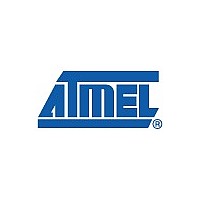SAM7X128 Atmel Corporation, SAM7X128 Datasheet - Page 458

SAM7X128
Manufacturer Part Number
SAM7X128
Description
Manufacturer
Atmel Corporation
Specifications of SAM7X128
Flash (kbytes)
128 Kbytes
Pin Count
100
Max. Operating Frequency
55 MHz
Cpu
ARM7TDMI
Hardware Qtouch Acquisition
No
Max I/o Pins
62
Ext Interrupts
62
Usb Transceiver
1
Usb Speed
Full Speed
Usb Interface
Device
Spi
2
Twi (i2c)
1
Uart
3
Can
1
Ssc
1
Ethernet
1
Graphic Lcd
No
Video Decoder
No
Camera Interface
No
Adc Channels
8
Adc Resolution (bits)
10
Adc Speed (ksps)
384
Resistive Touch Screen
No
Temp. Sensor
No
Crypto Engine
No
Sram (kbytes)
32
Self Program Memory
NO
Dram Memory
No
Nand Interface
No
Picopower
No
Temp. Range (deg C)
-40 to 85
I/o Supply Class
3.3
Operating Voltage (vcc)
3.0 to 3.6
Fpu
No
Mpu / Mmu
no / no
Timers
3
Output Compare Channels
3
Input Capture Channels
3
Pwm Channels
4
32khz Rtc
Yes
Calibrated Rc Oscillator
No
- Current page: 458 of 687
- Download datasheet (11Mb)
34.5.2.3
Figure 34-9. Data OUT Transfer for Non Ping-pong Endpoints
458
RX_DATA_BK0
(UDP_CSRx)
USB Bus
Packets
FIFO (DPR)
Content
Data OUT Transaction Without Ping-pong Attributes
Using Endpoints With Ping-pong Attributes
SAM7X512/256/128
Data OUT Transaction
Data OUT
PID
Host Sends Data Payload
Written by USB Device
Data OUT 1
Data OUT transactions are used in control, isochronous, bulk and interrupt transfers and con-
duct the transfer of data from the host to the device. Data OUT transactions in isochronous
transfers must be done using endpoints with ping-pong attributes.
To perform a Data OUT transaction, using a non ping-pong endpoint:
An interrupt is pending while the flag RX_DATA_BK0 is set. Memory transfer between the USB
device, the FIFO and microcontroller memory can not be done after RX_DATA_BK0 has been
cleared. Otherwise, the USB device would accept the next Data OUT transfer and overwrite the
current Data OUT packet in the FIFO.
During isochronous transfer, using an endpoint with ping-pong attributes is obligatory. To be
able to guarantee a constant bandwidth, the microcontroller must read the previous data pay-
load sent by the host, while the current data payload is received by the USB device. Thus two
Data OUT 1
1. The host generates a Data OUT packet.
2. This packet is received by the USB device endpoint. While the FIFO associated to this
3. The microcontroller is notified that the USB device has received a data payload polling
4. The number of bytes available in the FIFO is made available by reading RXBYTECNT
5. The microcontroller carries out data received from the endpoint’s memory to its mem-
6. The microcontroller notifies the USB device that it has finished the transfer by clearing
7. A new Data OUT packet can be accepted by the USB device.
endpoint is being used by the microcontroller, a NAK PID is returned to the host. Once
the FIFO is available, data are written to the FIFO by the USB device and an ACK is
automatically carried out to the host.
RX_DATA_BK0 in the endpoint’s UDP_ CSRx register. An interrupt is pending for this
endpoint while RX_DATA_BK0 is set.
in the endpoint’s UDP_ CSRx register.
ory. Data received is available by reading the endpoint’s UDP_ FDRx register.
RX_DATA_BK0 in the endpoint’s UDP_ CSRx register.
Set by USB Device
ACK
Host Sends the Next Data Payload
Microcontroller Read
PID
Microcontroller Transfers Data
Data OUT 1
Data OUT2
Interrupt Pending
PID
Data OUT2
NAK
PID
Cleared by Firmware,
Data Payload Written in FIFO
Data OUT
PID
Host Resends the Next Data Payload
Written by USB Device
Data OUT 2
Data OUT2
6120I–ATARM–06-Apr-11
ACK
PID
Related parts for SAM7X128
Image
Part Number
Description
Manufacturer
Datasheet
Request
R

Part Number:
Description:
INTERVAL AND WIPE/WASH WIPER CONTROL IC WITH DELAY
Manufacturer:
ATMEL Corporation
Datasheet:

Part Number:
Description:
Low-Voltage Voice-Switched IC for Hands-Free Operation
Manufacturer:
ATMEL Corporation
Datasheet:

Part Number:
Description:
MONOLITHIC INTEGRATED FEATUREPHONE CIRCUIT
Manufacturer:
ATMEL Corporation
Datasheet:

Part Number:
Description:
AM-FM Receiver IC U4255BM-M
Manufacturer:
ATMEL Corporation
Datasheet:

Part Number:
Description:
Monolithic Integrated Feature Phone Circuit
Manufacturer:
ATMEL Corporation
Datasheet:

Part Number:
Description:
Multistandard Video-IF and Quasi Parallel Sound Processing
Manufacturer:
ATMEL Corporation
Datasheet:

Part Number:
Description:
High-performance EE PLD
Manufacturer:
ATMEL Corporation
Datasheet:

Part Number:
Description:
8-bit Flash Microcontroller
Manufacturer:
ATMEL Corporation
Datasheet:

Part Number:
Description:
2-Wire Serial EEPROM
Manufacturer:
ATMEL Corporation
Datasheet:

Part Number:
Description:
U6046BREAR WINDOW HEATING TIMER / LONG-TERM TIMER
Manufacturer:
ATMEL Corporation
Datasheet:










